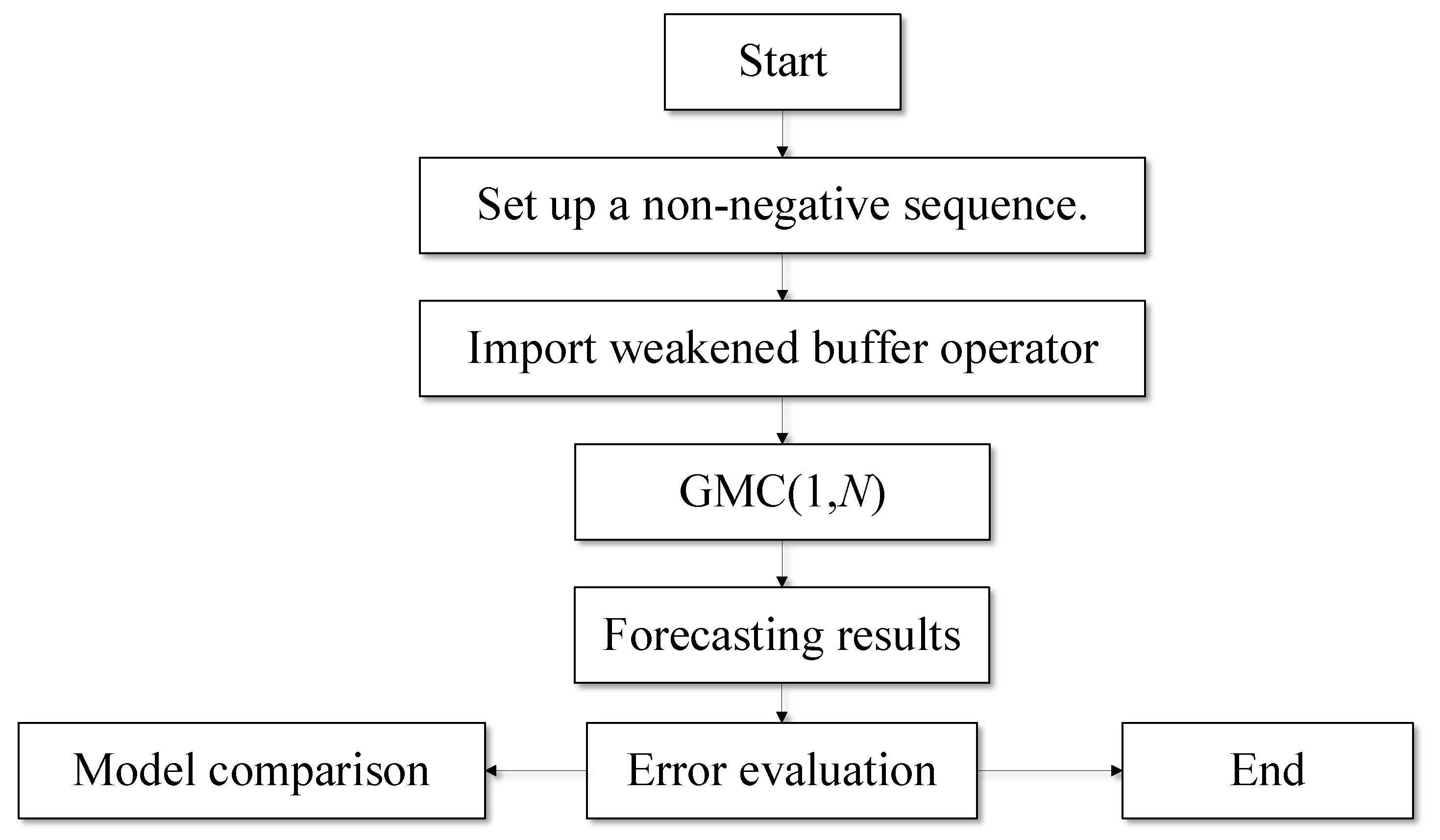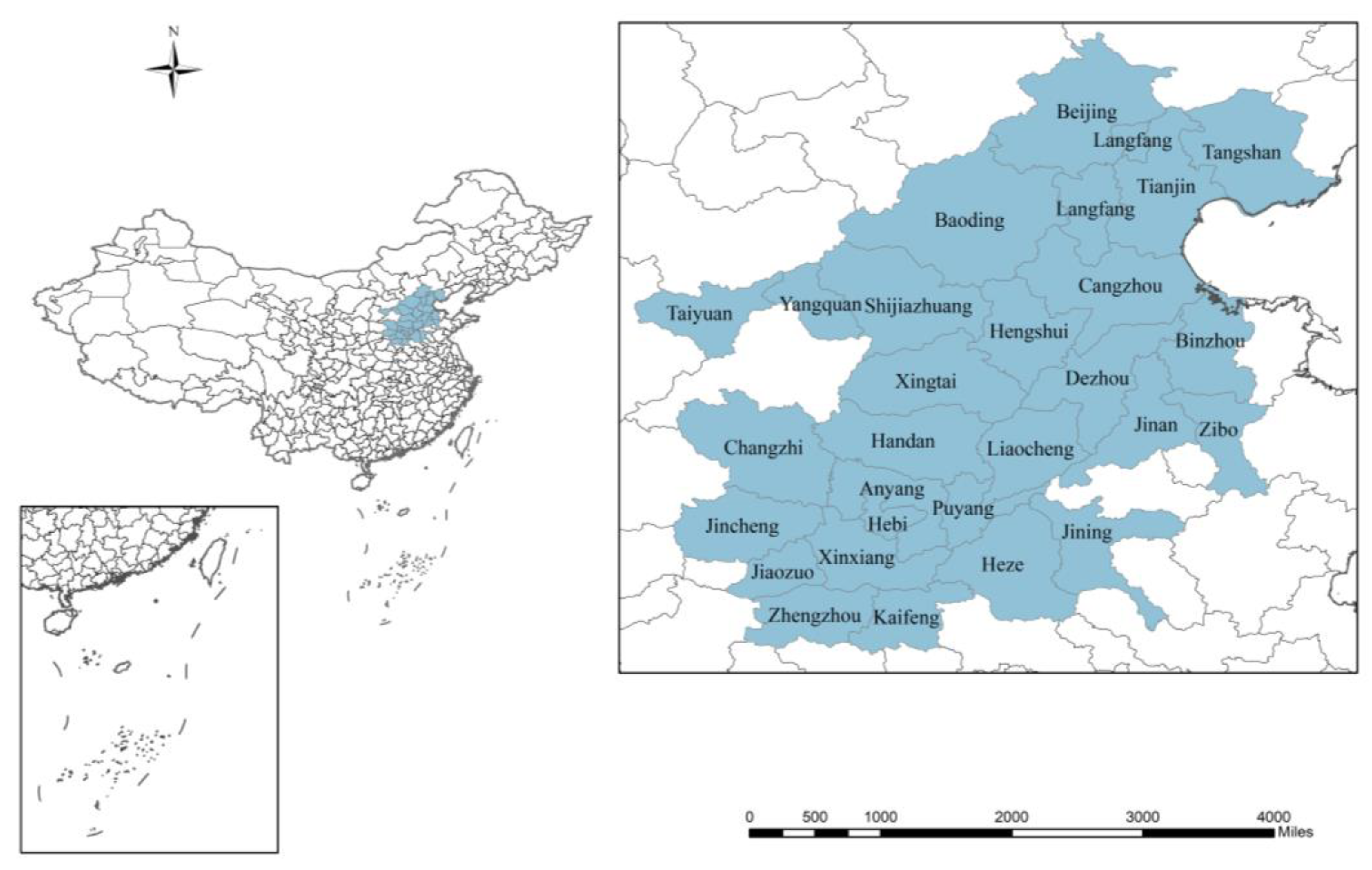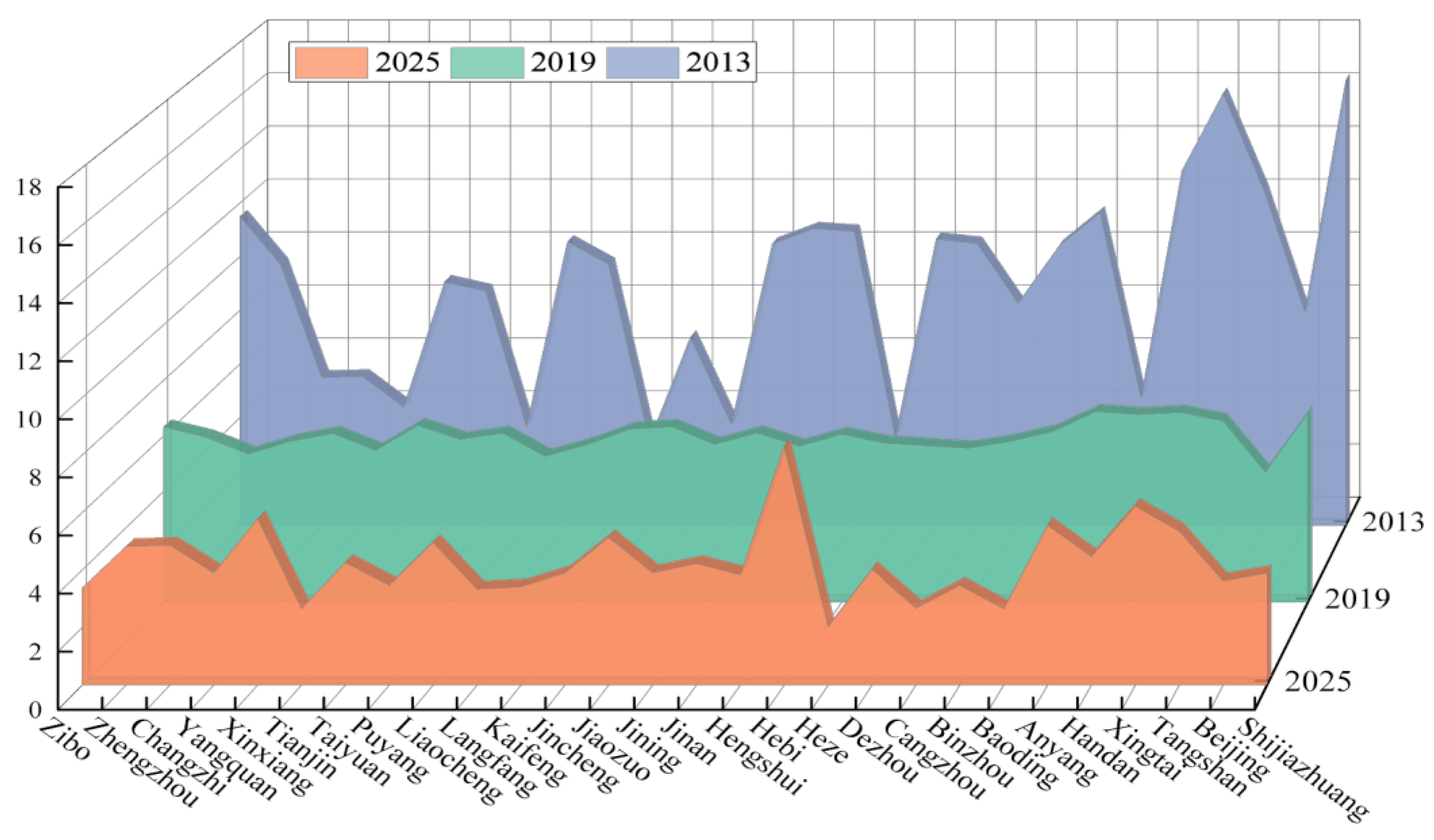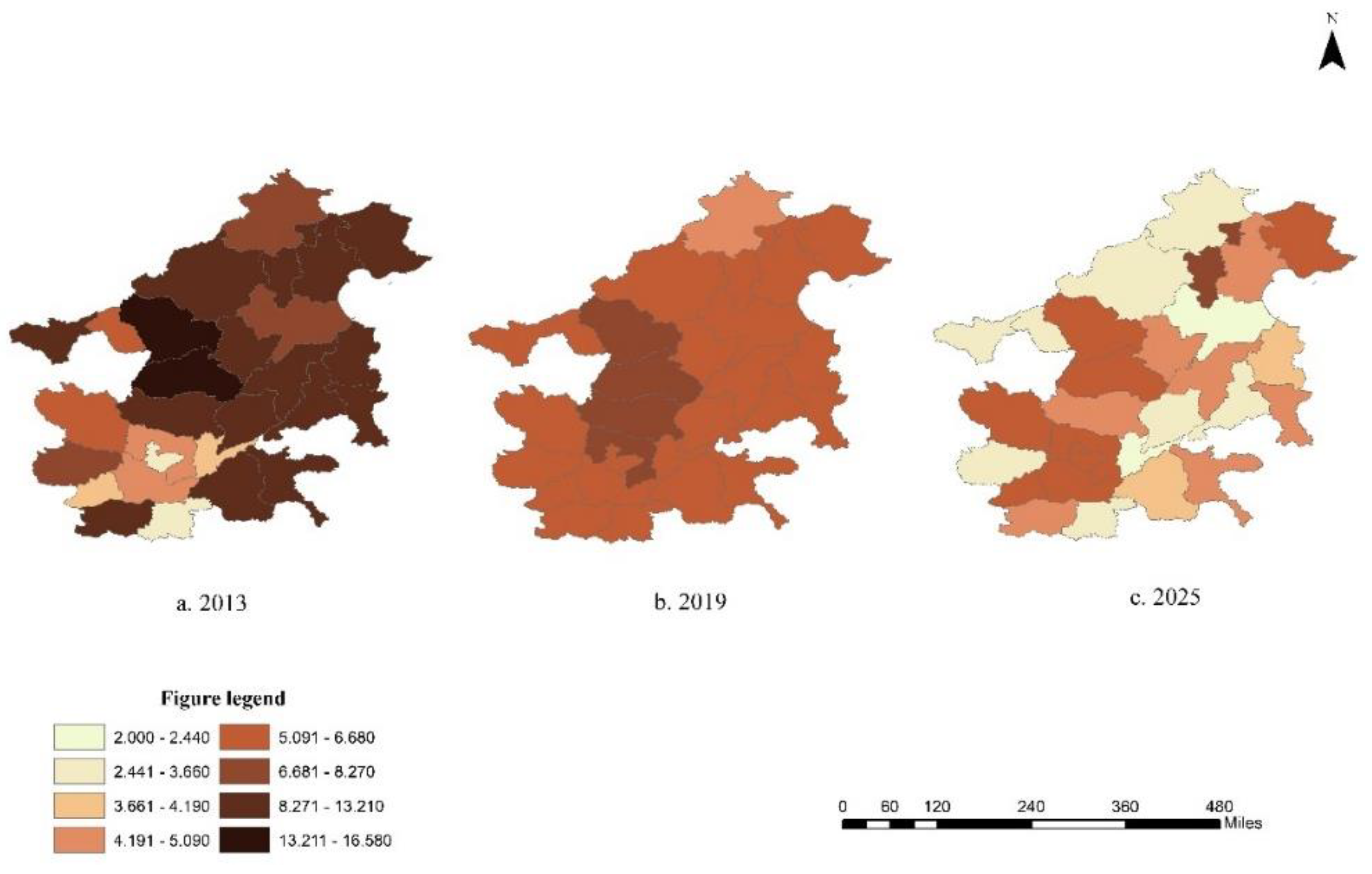Analysis of Air Quality Evolution Trends in the Chinese Air Pollution Transmission Channel Cities under Socioeconomic Development Scenarios
Abstract
1. Introduction
2. Grey Multivariable Convolution Model with a Single-Indicator Buffer
2.1. Modeling Process of SGMC(1,N)
2.2. Stability Analysis of SGMC(1,N)
3. AQCI Forecast for “2+26” Cities in China’s Air Pollution Transmission Corridor
3.1. AQCI Prediction under the Secondary Industry Development Scenario
3.2. AQCI Prediction under the Population Density Development Scenario
3.3. AQCI Prediction under the Urbanization Development Scenario
4. Conclusions
Author Contributions
Funding
Institutional Review Board Statement
Informed Consent Statement
Data Availability Statement
Conflicts of Interest
References
- Lanzi, E.; Dellink, R.; Chateau, J. The sectoral and regional economic consequences of outdoor air pollution to 2060. Energy Econ. 2018, 71, 89–113. [Google Scholar] [CrossRef]
- Li, X. Air quality forecasting based on GAB and fuzzy BP neural network. J. Huazhong Univ. Sci. Technol. (Nat. Sci. Ed.) 2013, 41 (Suppl. S1), 63–65+69. [Google Scholar]
- Hu, J.; Yang, H.J.; Cheng, C. PM2.5 concentration prediction model based on BP neural network of improved artificial bee colony. J. Shandong Jiaotong Univ. 2020, 4, 15–22. [Google Scholar]
- Gan, L.Q.; Liu, Y.H. Air Quality Index Prediction Based on Outlier Detection and Error Correction. Comput. Syst. Appl. 2021, 3, 250–255. [Google Scholar]
- Gong, P.B.; Guo, H.P.; Duan, Z.S. Improved BP Neural Network Method for Predicting Environmental Radon Concentration. Nucl. Electron. Detect. Technol. 2019, 3, 279–284. [Google Scholar]
- Liang, Z.; Wang, Y.Y.; Yue, Y.W. A coupling model of genetic algorithm and RBF neural network for the prediction of PM2.5 concentration. China Environ. Sci. 2020, 40, 523–529. [Google Scholar]
- Zhao, G.Y.; Ma, F. Prediction of Dust Concentration Based on Particle Swarm Optimization BP Neural Network. Meas. Control Technol. 2018, 37, 20–23. [Google Scholar]
- Luo, S.Q.; Liu, H.T. Prediction of atmospheric pollution based on BP neural network optimized by hybrid algorithms. J. Nat. Sci. Heilongjiang Univ. 2020, 37, 389–394. [Google Scholar]
- Zhang, C.; Tang, W.; Xiao, J.; Tao, T.; Yuan, W.H.; Du, J.J.; Shu, y. Development and Application of Artificial Intelligence-Based System for Air Quality Prediction. Environ. Sci. Technol. 2020, 43 (Suppl. S2), 188–193. [Google Scholar]
- Li, J.G.; Luo, A.R.; Li, X.L. Prediction of PM2.5 Mass Concentration Based on Complementary Ensemble Empirical Mode Decomposition and Support Vector Regression. J. Beijing Univ. Technol. 2018, 44, 1494–1502. [Google Scholar]
- Chen, J.F.; Li, Y. Forecasting of PM2.5 concentration based on multimodal support vector regression. Environ. Eng. 2019, 37, 122–126+34. [Google Scholar]
- Sun, W.; Sun, J.Y. Daily PM2.5 concentration prediction based on principal component analysis and LSSVM optimized by cuckoo search algorithm. Environ. Manag. 2017, 188, 144–152. [Google Scholar]
- Shams, S.R.; Jahani, A.; Kalantary, S.; Moeinaddini, M.; Khorasani, N. The evaluation on artificial neural networks (ANN) and multiple linear regressions (MLR) models for predicting SO2 concentration. Urban Clim. 2021, 37, 100837. [Google Scholar] [CrossRef]
- Maciag, P.S.; Kasabov, N.; Kryszkiewicz, M.; Bembenik, R. Air pollution prediction with clustering-based ensemble of evolving spiking neural networks and a case study for London area. Environ. Model. Softw. 2019, 118, 262–280. [Google Scholar] [CrossRef]
- Tu, L.P.; Chen, Y. An unequal adjacent grey forecasting air pollution urban model. Appl. Math. Model. 2021, 99, 260–275. [Google Scholar] [CrossRef]
- Xu, S.; Zou, B.; Shafi, S.; Sternberg, T. A hybrid Grey-Markov/LUR model for PM10 concent ration prediction under future urban scenarios. Atmos. Environ. 2018, 187, 401–409. [Google Scholar] [CrossRef]
- Xiong, P.P.; Yan, W.J.; Wang, G.Z.; Pei, L.-L. Grey extended prediction model based on IRLS and its application on smog pollution. Appl. Soft Comput. 2019, 80, 797–809. [Google Scholar] [CrossRef]
- Xiong, P.P.; Shi, J.; Pei, L.L.; Ding, S. A novel linear time-varying GM(1,N) model for forecasting haze: A case study of Beijing, China. Sustainability 2019, 11, 3832. [Google Scholar] [CrossRef]
- Shi, K.H.; Wu, L.F. Modelling the relationship between population density and air quality using fractional Hausdorff grey multivariate model. Kybernetes 2021, 50, 3129–3150. [Google Scholar] [CrossRef]
- Ofosu-Adarkwa, J.; Xie, N.M.; Javed, S.A. Forecasting CO2 emissions of China’s cement industry using a hybrid Verhulst-GM(1,N) model and emissions’ technical conversion. Renew. Sustain. Energy Rev. 2020, 130, 109945. [Google Scholar] [CrossRef]
- Chen, H.; Xiao, X.P.; Wen, J.H. Novel multivariate compositional data’s model for structurally analyzing sub-industrial energy consumption with economic data. Neural Comput. Appl. 2020, 6, 3713–3735. [Google Scholar] [CrossRef]
- Zhang, Z.Y.; Wu, L.F.; Chen, Y. Forecasting PM2.5 and PM10 concentrations using GMCN(1,N) model with the similar meteorological condition: Case of Shijiazhuang in China. Ecol. Indic. 2020, 119, 106871. [Google Scholar] [CrossRef]
- Ma, X.; Liu, Z.B. The GMC(1,N) model with optimized parameters and its application. J. Grey Syst. 2017, 29, 122–138. [Google Scholar]
- Zhang, Y.B.; Chen, X.; Yu, S.C.; Wang, L.; Li, Z.; Li, M.; Liu, W.; Li, P.; Rosenfeld, D.; Seinfeld, J.H. City-level air quality improvement in the Beijing-Tianjin-Hebei region from 2016/17 to 2017/18 heating seasons: Attributions and process analysis. Environ. Pollut. 2021, 271, 116523. [Google Scholar] [CrossRef]
- Xu, M.; Zhang, S.H.; Xie, Y. Impacts of the clean residential combustion policies on environment and health in the Beijing–Tianjin–Hebei area. J. Clean. Prod. 2023, 384, 135560. [Google Scholar] [CrossRef]
- Zhang, Z.Y.; Zhao, X.J.; Mao, R.; Xu, J.; Kim, S.-J. Predictability of the winter haze pollution in Beijing–Tianjin–Hebei region in the context of stringent emission control. Atmos. Pollut. Res. 2022, 13, 101392. [Google Scholar] [CrossRef]
- Zhou, W.J.; Zhang, H.R.; Dang, Y.G.; Wang, Z.X. New information priority accumulated grey discrete model and its application. Chin. J. Manag. Sci. 2017, 25, 140–148. [Google Scholar]
- Dai, H. Matrix Theory; Science Press: Beijing, China, 2001. [Google Scholar]
- Shi, K.H.; Wu, L.F. Forecasting air quality considering the socio-economic development in Xingtai. Sustain. Cities Soc. 2020, 61, 102337. [Google Scholar] [CrossRef]
- Borck, R.; Schrauth, P. Population density and urban air quality. Reg. Sci. Urban Econ. 2021, 86, 103596. [Google Scholar] [CrossRef]
- Khan, I.; Hou, F.J.; Le, H.P.; Ali, S.A. Do natural resources, urbanization, and value-adding manufacturing affect environmental quality? Evidence from the top ten manufacturing countries. Resour. Policy 2021, 72, 102109. [Google Scholar] [CrossRef]
- Meda, U.S.; Vora, K.; Athreya, Y.; Mandi, U.A. Titanium dioxide based heterogeneous and heterojunction photocatalysts for pollution control applications in the construction industry. Process Saf. Environ. Prot. 2022, 161, 771–787. [Google Scholar] [CrossRef]
- Zhao, H.; Chen, K.Y.; Liu, Z.; Zhang, Y.; Shao, T.; Zhang, H. Coordinated control of PM2.5 and O3 is urgently needed in China after implementation of the “Air pollution prevention and control action plan”. Chemosphere 2021, 270, 129441. [Google Scholar] [CrossRef] [PubMed]
- Leveque, B.; Burnet, J.-B.; Dorner, S.; Bichai, F. Impact of climate change on the vulnerability of drinking water intakes in a northern region. Sustain. Cities Soc. 2021, 66, 102656. [Google Scholar] [CrossRef]
- Wright, C.; Nyberg, D.; Bowden, V. Beyond the discourse of denial: The reproduction of fossil fuel hegemony in Australia. Energy Res. Soc. Sci. 2021, 77, 102094. [Google Scholar] [CrossRef]
- Gyamfi, B.A.; Adedoyin, F.F.; Bein, M.A.; Bekun, F.V.; Agozie, D.Q. The anthropogenic consequences of energy consumption in E7 economies: Juxtaposing roles of renewable, coal, nuclear, oil and gas energy: Evidence from panel quantile method. J. Clean. Prod. 2021, 295, 126373. [Google Scholar] [CrossRef]
- Ahmed, Z.; Asghar, M.M.; Malik, M.N.; Nawaz, K. Moving towards a sustainable environment: The dynamic linkage between natural resources, human capital, urbanization, economic growth, and ecological footprint in China. Resour. Policy 2020, 67, 101677. [Google Scholar] [CrossRef]
- Cheng, Z.H.; Wang, L. Can new urbanization improve urban total-factor energy efficiency in China? Energy 2023, 266, 126494. [Google Scholar] [CrossRef]
- Su, M.; Wang, Q.; Li, R.R.; Wang, L. Per capita renewable energy consumption in 116 countries: The effects of urbanization, industrialization, GDP, aging, and trade openness. Energy 2022, 254, 124289. [Google Scholar] [CrossRef]
- Liang, L.W.; Wang, Z.B.; Li, J.X. The effect of urbanization on environmental pollution in rapidly developing urban agglomerations. J. Clean. Prod. 2019, 237, 117649. [Google Scholar] [CrossRef]
- Wang, Z.H.; Liu, B.; Wang, L.S.; Shao, Q. Measurement and temporal & spatial variation of urban eco-efficiency in the Yellow River Basin. Phys. Chem. Earth 2021, 122, 102981. [Google Scholar]





| Relevant Factors | Indicators | Units |
|---|---|---|
| Industrial development | Secondary industry added value | CNY billion |
| Population pressure | Population density | People/square kilometer |
| Urbanization | Urbanization ratio | % |
| Year | Predicted Value |
|---|---|
| 2020 | 6.56 |
| 2021 | 6.33 |
| 2022 | 6.12 |
| 2023 | 5.93 |
| 2024 | 5.74 |
| 2025 | 5.57 |
| MAPE | 0.79% |
| City | Model | 2013 | 2014 | 2015 | 2016 | 2017 | 2018 | 2019 | MAPE |
|---|---|---|---|---|---|---|---|---|---|
| Anyang | GM(1,N) | 7.56 | 6.67 | 8.02 | 7.67 | 8.34 | 8.46 | 8.57 | 13.41% |
| GM(0,N) | 7.56 | 7.41 | 6.46 | 6.71 | 7.57 | 7.76 | 7.88 | 11.71% | |
| AGMC(1,N) | 7.56 | 7.07 | 7.27 | 7.50 | 7.23 | 6.69 | 6.45 | 4.91% | |
| SGMC(1,N) | 7.56 | 7.07 | 7.27 | 7.50 | 7.23 | 6.69 | 6.45 | 0.79% | |
| Heze | GM(1,N) | 7.80 | −16.94 | −440.91 | / | / | / | / | >100% |
| GM(0,N) | 7.80 | 5.55 | 5.91 | 6.12 | 6.80 | 7.32 | 6.78 | 13.56% | |
| AGMC(1,N) | 7.80 | 7.33 | 7.22 | 7.03 | 6.76 | 6.39 | 5.93 | 0.56% | |
| SGMC(1,N) | 7.80 | 7.35 | 7.20 | 7.00 | 6.71 | 6.33 | 5.90 | 0.46% | |
| Jinzhong | GM(1,N) | 6.89 | 5.41 | 7.54 | 6.93 | 7.30 | 8.27 | 8.42 | 18,04% |
| GM(0,N) | 6.89 | 6.24 | 5.90 | 5.69 | 6.34 | 7.36 | 7.54 | 13.67% | |
| AGMC(1,N) | 6.89 | 5.13 | 6.88 | 5.42 | 6.91 | 5.09 | 6.25 | 9.88% | |
| SGMC(1,N) | 6.89 | 6.90 | 6.80 | 6.72 | 6.61 | 6.42 | 6.16 | 1.26% | |
| Tianjin | GM(1,N) | 9.07 | −12.36 | −239.22 | / | / | / | / | >100% |
| GM(0,N) | 9.07 | 6.54 | 6.51 | 6.75 | 6.40 | 6.41 | 4.19 | 10.83% | |
| AGMC(1,N) | 9.07 | 7.61 | 7.46 | 6.77 | 6.03 | 5.24 | 5.43 | 4.11% | |
| SGMC(1,N) | 9.07 | 7.61 | 7.46 | 6.77 | 6.03 | 5.24 | 5.43 | 3.60% | |
| Handan | GM(1,N) | 13.21 | −16.18 | −525.86 | / | / | / | / | >100% |
| GM(0,N) | 13.21 | 7.48 | 7.28 | 7.64 | 8.65 | 7.55 | 7.54 | 11.89% | |
| AGMC(1,N) | 13.21 | 9.63 | 9.49 | 8.74 | 7.59 | 6.78 | 6.81 | 3.38% | |
| SGMC(1,N) | 13.21 | 9.95 | 9.13 | 8.39 | 7.76 | 7.19 | 6.66 | 2.72% |
| City | 2020 | 2021 | 2022 | 2023 | 2024 | 2025 | MAPE |
|---|---|---|---|---|---|---|---|
| Zibo | 5.29 | 4.76 | 4.32 | 3.95 | 3.64 | 3.38 | 2.73% |
| Zhengzhou | 5.65 | 5.45 | 5.27 | 5.11 | 4.96 | 4.82 | 0.93% |
| Changzhi | 6.57 | 6.32 | 6.03 | 5.70 | 5.31 | 4.87 | 2.21% |
| Yangquan | 5.45 | 5.16 | 4.86 | 4.56 | 4.24 | 3.91 | 1.00% |
| Xinxiang | 6.00 | 5.95 | 5.90 | 5.86 | 5.82 | 5.80 | 0.48% |
| Tianjin | 4.67 | 4.16 | 3.72 | 3.33 | 2.98 | 2.66 | 3.60% |
| Taiyuan | 6.03 | 5.73 | 5.40 | 5.05 | 4.68 | 4.27 | 0.90% |
| Puyang | 4.74 | 4.46 | 4.21 | 3.96 | 3.72 | 3.47 | 7.89% |
| Liaocheng | 5.54 | 5.32 | 5.15 | 5.03 | 4.97 | 4.97 | 2.08% |
| Langfang | 4.70 | 4.32 | 4.00 | 3.74 | 3.52 | 3.34 | 1.11% |
| Kaifeng | 5.21 | 4.85 | 4.49 | 4.14 | 3.78 | 3.43 | 1.35% |
| Jincheng | 5.88 | 5.56 | 5.20 | 4.81 | 4.38 | 3.91 | 1.26% |
| Jiaozuo | 6.02 | 5.82 | 5.63 | 5.45 | 5.29 | 5.14 | 1.01% |
| Jining | 4.97 | 4.64 | 4.39 | 4.19 | 4.03 | 3.91 | 2.44% |
| Jinan | 5.43 | 5.08 | 4.80 | 4.57 | 4.38 | 4.24 | 2.79% |
| Hengshui | 5.13 | 4.83 | 4.56 | 4.30 | 4.06 | 3.84 | 1.28% |
| Hebi | 6.88 | 7.17 | 7.46 | 7.75 | 8.04 | 8.34 | 5.91% |
| Heze | 5.47 | 4.96 | 4.36 | 3.68 | 2.91 | 2.03 | 0.46% |
| Dezhou | 5.20 | 4.92 | 4.67 | 4.44 | 4.23 | 4.03 | 1.19% |
| Cangzhou | 5.12 | 4.69 | 4.23 | 3.75 | 3.23 | 2.67 | 0.81% |
| Binzhou | 5.22 | 4.83 | 4.47 | 4.12 | 3.79 | 3.48 | 2.15% |
| Baoding | 5.21 | 4.54 | 3.97 | 3.47 | 3.03 | 2.65 | 1.19% |
| Handan | 6.19 | 5.77 | 5.39 | 5.05 | 4.75 | 4.48 | 2.72% |
| Xingtai | 6.62 | 6.49 | 6.39 | 6.32 | 6.27 | 6.23 | 0.58% |
| Tangshan | 6.15 | 5.89 | 5.70 | 5.55 | 5.44 | 5.36 | 0.61% |
| Beijing | 4.42 | 4.22 | 4.05 | 3.89 | 3.75 | 3.63 | 0.69% |
| Shijiazhuang | 6.01 | 5.45 | 4.98 | 4.57 | 4.22 | 3.90 | 4.19% |
Disclaimer/Publisher’s Note: The statements, opinions and data contained in all publications are solely those of the individual author(s) and contributor(s) and not of MDPI and/or the editor(s). MDPI and/or the editor(s) disclaim responsibility for any injury to people or property resulting from any ideas, methods, instructions or products referred to in the content. |
© 2023 by the authors. Licensee MDPI, Basel, Switzerland. This article is an open access article distributed under the terms and conditions of the Creative Commons Attribution (CC BY) license (https://creativecommons.org/licenses/by/4.0/).
Share and Cite
Shi, K.; Liu, H.; Zhang, L.; Li, Q. Analysis of Air Quality Evolution Trends in the Chinese Air Pollution Transmission Channel Cities under Socioeconomic Development Scenarios. Sustainability 2023, 15, 2118. https://doi.org/10.3390/su15032118
Shi K, Liu H, Zhang L, Li Q. Analysis of Air Quality Evolution Trends in the Chinese Air Pollution Transmission Channel Cities under Socioeconomic Development Scenarios. Sustainability. 2023; 15(3):2118. https://doi.org/10.3390/su15032118
Chicago/Turabian StyleShi, Kaihe, Huiru Liu, Li Zhang, and Qing Li. 2023. "Analysis of Air Quality Evolution Trends in the Chinese Air Pollution Transmission Channel Cities under Socioeconomic Development Scenarios" Sustainability 15, no. 3: 2118. https://doi.org/10.3390/su15032118
APA StyleShi, K., Liu, H., Zhang, L., & Li, Q. (2023). Analysis of Air Quality Evolution Trends in the Chinese Air Pollution Transmission Channel Cities under Socioeconomic Development Scenarios. Sustainability, 15(3), 2118. https://doi.org/10.3390/su15032118





